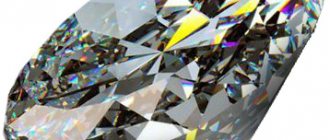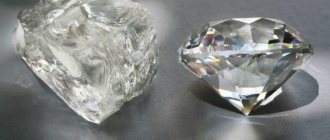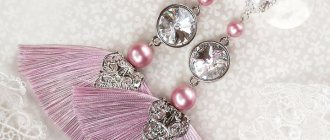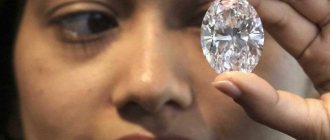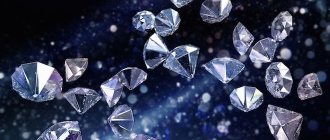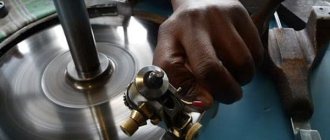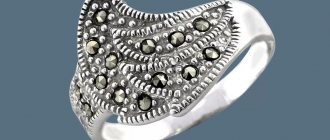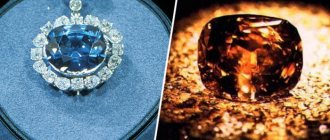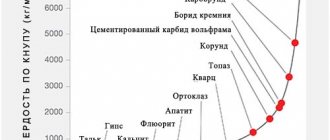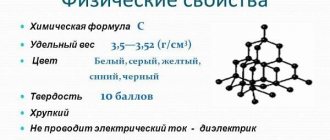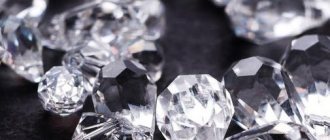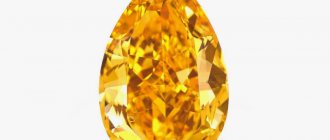Ancient Hindus believed that diamond was formed from 5 elements - wind, water, fire, earth and energy. In some ways they were right: at a depth of 200 km underground, under the influence of high temperature and pressure in molten rock, the most durable and mysterious crystals on Earth are born. But immediately after extraction, these crystals are of no interest - not a single day of painstaking work by specialists is needed for a shapeless and rough stone to shine in the rays of the sun and receive the proud name of a diamond. A diamond is a cut diamond, and its final value depends on how many facets a diamond has, its weight, color and clarity. Even a hundredth of a carat can add a third of the cost of a diamond, and, on the contrary, reduce defects, so most often raw diamonds are cut into pieces, and then, using a special scanner and three-dimensional modeling, the optimal cutting method is calculated.
Why do diamonds need cutting and polishing?
Cut is one of the four most important quality characteristics of a diamond (the other three being color, clarity, and carat weight). This is a process in which a diamond is shaped into a specific shape and a rough piece of material is turned into a polished, faceted stone.
More precisely, cut refers to a configuration with a specific arrangement and shape of the facets.
Natural diamonds mined from the earth are called “rough diamonds.” The highest quality of them will go into jewelry production. There they will be polished, cut and set into jewelry. This is done for several reasons.
First, it must be symmetrical and standardized to fit into a standard jewelry setting.
Secondly, buyers prefer diamonds of various shapes, so jewelry sellers provide a wide range of stones in various sizes and configurations. Third, cutting and polishing enhance the brightness, brilliance, and sparkle of the stone.
Of course, not all diamond shapes maximize the reflective characteristics of the stone, however, the value of a diamond is primarily measured by its ability to sparkle and sparkle.
For example, the round cut is the most popular because it has the highest sparkle and brightness characteristics.
When processing stone, it is very important to emphasize and enhance its advantages. This is a very difficult task, since the specialist needs to balance four parameters (weight, cut, clarity and color) in order to achieve the greatest value and, therefore, value of the diamond.
For example, if a stone has a lot of visible inclusions, then the jeweler will have to choose: improve the clarity of the stone, but lose weight, or maintain weight, but with a low level of clarity.
Crystal structure and method of formation
Adamantium crystals in nature are formed deep in the bowels of the earth. A prerequisite is high temperature and pressure, forcing carbon atoms to compress into a crystal lattice with strong bonds. Diamond is a cubic crystalline modification of carbon. It can be formed under natural and artificial conditions. Diamond crystals can take the form:
- Cuba;
- rhombic dodecahedron;
- tetrahedron;
- octahedron.
For diamond crystallization to start under natural conditions, a pressure of about 40,000 atmospheres is required, which corresponds to a depth of about 140 km. The temperature at this depth reaches about 900 °C.
Important: free carbon requires a small amount of oxygen to crystallize diamond. Otherwise, the reaction will lead to the formation of carbon monoxide or monoxide. During the growth process, a diamond crystal can capture environmental molecules - minerals or fluids. Such inclusions affect the color of the final diamond.
How are diamonds processed?
Since diamonds are very hard, cutting them is very difficult and difficult. Rough diamonds are sawed and cut using special blades and lasers.
Very often, rough diamonds are analyzed using 3D technology to reproduce and clearly see how the stone will turn out and what is the best way to cut it.
After the diamond is cut into certain pieces, their shape and configuration of the edges are formed and only then polished.
Allotropic modifications
The same chemical element can exist in the forms of several substances. This phenomenon is called allotropy. In the crystal lattice of diamond, the basis is carbon. But besides adamant, there are other crystals and substances with a similar chemical composition. The difference in this case lies in the arrangement of the atoms. Elements with an atomic mass greater than diamond have greater distance between their atoms, which makes them less strong.
Allotropic modifications include:
- coal;
- graphite – it is characterized by a hexagonal crystal lattice and pi bonds, there are free electrons;
- carbine - an artificial crystal, black, with a very small grain size, most often presented in powder form;
- fullerenes are also an artificial form, the crystal lattice resembles the shape of a soccer ball with a base of octagons;
- carbon nanotubes;
- Longsdaleites are “meteorite” diamonds with a hexagonal crystal lattice.
All allotropic modifications have the property of being transformed into graphite when exposed to temperatures above 1800 °C.
Diamond cutting.
Cutting is an important step in diamond processing. This process involves cutting off the facets that form the final shape of the diamond.
The number, shape and arrangement of facets determine the type of cut. For example, a round cut must have a certain number of facets, with a designated shape and arrangement that strictly complies with standards and recommendations.
Faceting is important because the shape and arrangement of the edges ultimately affects the ability to reflect and refract incoming light.
That is, how much light will pass deep into the stone and how much can be reflected on the surface of the top or on another section of the stone.
This is extremely important for the quality of the stone because the more light that returns to the surface, the brighter and more brilliant the diamond will be. Disproportional, asymmetrical, and irregularly shaped facets will result in a low grade diamond that will be dark and dull.
However, there are types of cuts that are not designed to maximize brilliance; they are interesting for their shape and parallel edges. For example, the emerald cut is also quite popular, although such a diamond is not distinguished by the brightness of its brilliance due to the peculiarities of its structure.
Modern processing
Cutting is the part of the diamond processing process that gives the stone its familiar appearance. Before cutting, a diamond may not seem so bright and beautiful. Therefore, the process should be led by an experienced jeweler in order to emphasize all the advantages of the stone and hide its shortcomings. As a result, we take into account:
- symmetry of edges;
- size of edges and their location;
- stone polishing.
These criteria affect the cost of the mineral. If we talk about the difference in price between two methods of cutting diamonds of the same shade and weight, then it reaches 30%.
Diamond elements
The most common method used to process diamonds is commercial cutting. There is also a fantasy technique, as a result of which stones acquire an unusual shape, but it is more complex and more expensive. And the usual commercial method also has its own subtypes that affect the cost.
There are types of cut “A”, “B” and “C”. They differ from each other in the loss of raw materials and the appearance of the diamond in the end. An “A” cut stone has ideal proportions, but there are large production losses. But the “B” and “C” cuts allow for inaccuracies in proportions, so the stone turns out to be stretched in length or height. Accordingly, it does not shine and play in the light as much. But only a jeweler can notice such irregularities, and a diamond will look just as beautiful in a piece of jewelry.
Each stone must have its own document, that is, a certificate, which indicates the type of cut of the stone. If it is type "A", the characteristics should be as follows:
| Pad size relative to diameter, % | 55–63 |
| Diamond height relative to diameter, % | 57–63 |
| The height of the girdle relative to the diameter, % | 1–2,5 |
If you purchased a stone in Russia, then there is a chance that the diamond cut will be of higher quality than that of minerals abroad. Because each country has its own standards, and the Russian Federation has more stringent ones.
The modern cutting method was invented and implemented by Marcel Tolkowsky. The first copy appeared in 1919. The essence of the cut is that light enters through the upper surface of the stone and is reflected from the lower edges. When reflected, rays of white light combine and turn into a rainbow. Therefore, now the method is recognized as classical and has certain parameters. Among the known and used methods today, the following are used:
- Tolkowski.
- Johnson and Roech.
- Eppler.
- Scandinavian diamond cut.
The stone often has 57 faces and is conventionally divided into the following parts:
- crown with platform;
- girdle;
- pavilion.
How to choose a diamond cut?
When purchasing a diamond, one of the decisions you must make is which cut to choose.
Let's take a look and learn more about how to choose the right cut for your stone.
The term shape is often used to refer to diamond cut, but the two terms do not mean the same thing.
While shape refers to the visible outline and overall appearance of a diamond, cut has a more comprehensive meaning that also includes the number, shape, dimensions and placement of the stone's facets.
For example, the princess, asscher, and radiant cuts are rectangular in shape, but differ in proportions and the way their edges are shaped and lined up.
How important is diamond cut?
To be fair, cut is perhaps the most significant quality characteristic of a diamond, sometimes more important than color, clarity and carat weight. This does not mean that it does not matter how clear or colorless the stone is.
However, the way a diamond is cut determines how well it will reflect light and how much sparkle and sparkle it will have as a result.
A properly proportioned diamond cut can appear so brilliant that its brilliance makes imperfect color or clarity less visible.
On the other hand, a diamond of the same clarity and color scale, but with a poorer cut, will not have the same brilliance. Not only will such a stone appear less vibrant, but its natural imperfections and yellowish tones will be more noticeable.
How a Diamond Becomes a Diamond
If you think that it is realistic to cut a diamond at home, we hasten to disappoint you. Nowadays, before cutting, the mineral goes through several stages of preparation. First, the stone is assessed by experts who determine the degree of its jewelry: color, purity, number of defects. One rough diamond can produce several diamonds if cutters decide that smaller stones will be more expensive than the largest one. Read more about the difference between a diamond and a diamond →
To find large stones, the ore is x-rayed in special machines - diamonds tend to glow for some time after irradiation. After this, markings are applied to the rough diamond so as to cut off as little as possible, and the diamond will be as large as possible. But before falling into the hands of a cutter, diamonds undergo another level of processing - roughing.
How diamonds are cut:
- First, a specialist visually evaluates the raw diamond, looking for the optimal method of processing and dividing it into parts. Then he applies heated glue to the holder over the saw blade, coated with diamond chips and special oil. On average, it would take up to 4 hours to cut one average rough diamond.
- The second stage of the process is grinding, or shaping the rough diamond. The initial shape is set by a computer using 3D modeling, after which the cutter places the diamond on the cutting kitch (bearing arm) and securely fastens it. Then he presses a cast-iron disk against the stone, which, as it rotates, grinds off all the roughness left by the diamond cutter. They barely touch, but at the same time all the vices turn into dust. The grinding process takes another 3-4 hours.
- Cutting directly begins from the platform - the upper flat face of the stone. Following the platform, the rims are cut at such an angle that they optimally meet at the bottom of the product. The specialist carefully ensures that the edges are mirrored in relation to each other, maximally reflecting and scattering the light entering the stone. After all, this is how the quality of a diamond cut is determined. He is helped in this by a device that measures the angles of the diamond’s facets and gives them an inclination of 42°.
- The specialist then applies the edges that are located immediately below the flat area , the so-called crown. And then he carves a belt - a ring of edges that separates the crown from the rims.
- the finishing touch to turning diamonds into brilliants - it removes residual dust from cut stones.
What criteria are used when choosing a diamond cut?
Among the diamonds that are classified and certified, you can choose based on the quality of processing of each stone.
You can also compare diamonds based on their level of brilliance, and since this is a characteristic that is directly related to the size of the stone, you will indirectly choose a more proportional cut.
Sometimes, you can select certain proportions that suit some of your needs.
For example, for a setting that hides the bottom of the diamond, you may want to choose a stone that is cut less deeply than usual so that when set, a significant portion of its surface will be visible, making it appear larger.
What type of crystal lattice does a diamond have?
Diamond crystallizes in the cubic system. This is the strongest existing system, which determines the unique properties of diamonds. It has an atomic crystal lattice.
- Each atom is connected to four neighboring atoms by the strongest covalent sigma bond.
- All carbon atoms in diamond are located in the center of the tetrahedron.
- One unit cell of diamond is approximately 0.36 nm in size.
- The minimum distance between neighboring atoms in a diamond lattice is 0.15 nm.
When a crystal forms, the composition may contain foreign impurities - aluminum, boron, calcium, gases. The presence of a foreign element reduces the performance of a pure diamond, which is based entirely on carbon. That is why they try to remove areas of impurities during cutting. If foreign inclusions are located on the surface of the stone, they are removed. If the defect is inside the crystal and it is impossible to get rid of it, the diamond goes into the industrial category. Its value will be significantly lower than that of a jewelry sample.
Synthetic diamonds
Since not only the jewelry industry needs high-quality diamond raw materials, scientists have been searching for a solution to the problem of creating diamonds artificially for many years. Solving the problem would make it possible to make not only the production of jewelry cheaper, but would also satisfy the demand for electronics, medical and scientific equipment. In the second half of the twentieth century, the problem was solved; moreover, since 2003, gem-quality diamonds were artificially produced, which made a real revolution in the jewelry sector.
- The first way to convert graphite as a carbon source into diamond is to imitate the natural conditions of conversion - a combination of high pressure and temperature. The result was achieved through the use of electric current and a hydraulic press. The disadvantage of this method is its high cost, although the resulting stones meet the required qualities.
- The second way is to recreate the explosion. Here the pressure and the desired temperature are formed in the process of a sharp release of energy.
- The third option is to grow a diamond crystal in an airless methane environment.
Important: with an artificial explosion, the stones turn out to be small, but the methane environment allows you to obtain crystals of any size. Synthetic stones are mainly used for industrial needs. Graphite is a high-quality and inexpensive raw material, therefore the cost of such diamonds is significantly lower than that of their natural counterparts. At the same time, it is important to understand that it is almost impossible to distinguish an artificial diamond from a natural one “by eye”; it is possible to determine a synthetic double only in the laboratory.
Modern diamond cutting is carried out using lasers at the cutting stage, but grinding with diamond discs remains relevant. Perhaps technology will change soon - in the process of synthetic production, a stone was obtained from carbon, which was called ACNR. The stone was discovered in 2005 and showed a hardness superior to diamond. It can easily scratch them, which means it can become another tool for cutting gemstones.
